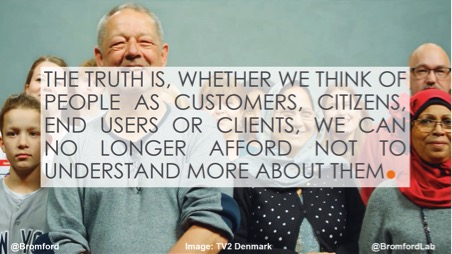
We caught up with the team at Bromford Lab to understand the challenges to innovating in a large and traditional organisation. The Lab works across Bromford, a Housing Association of 30,000 homes, to reimagine services, inspire new thinking and design new ways of working.
It seems that all organisations these days are talking about innovation. It’s true of all sectors, but perhaps one of the fastest growing in it’s thirst for innovation is the public and social facing sector, which is seeing a huge rise in the number of teams being setup to ‘drive change’ and ‘promote new working cultures’. But, often the same organisations who are calling for such teams, are at the same time internally confused about why or how they will work; often overlooking the fact that meaningful innovation is disruptive by its nature and the impact that disruption will likely make on the fabric of the organisation.
We wanted to make sure that when we started upon our own journey of innovation we understood this impact, so we spent around a year scoping out what an Innovation Lab at Bromford might look like. We could see that there was a need to create a space for other colleagues to think differently about the problems they faced and come up with new types of solutions which could help drive the business forward, but the form that this took was set to evolve over time. Often, colleagues were having ideas, but increasingly found that they had no way of taking them forward, or even worse, took them forward without understanding how they fitted with the rest of organisational strategy.
“It’s fair to say that [as an organisation] our focus on doing the right things for our customers has sometimes meant we followed our hearts rather than our heads – designing services around gut feelings, instincts and myths, rather than data, analytics and research.” Philippa Jones, Chief Executive, Bromford
The problem the Lab was set up to fix was that innovation was random and unfocused at Bromford. It happened at will, and there wasn’t a resource to nurture and protect new ideas from colleagues. We describe it as ‘initiative-itis’- there was an initiative for lots of things – but they didn’t always solve the right problem and weren’t always effective. Bromford Lab was launched back in 2014 as a place to nurture innovation. The Lab was founded using Jeff Bezos’ principle of being a Two Pizza Team, that teams shouldn’t be larger than two pizzas can feed. Small teams make it easier to communicate more effectively and encourage high autonomy and innovation. Since then we have been working across the business to help colleagues capture, frame and realise their ideas, with no pressure to force bad ideas to work. In fact, failing and failing fast was one of our founding principles. Over the past few years the lab approach has evolved. These days our Insight team (data analysis and research) and Innovation work closely together, and that has been important learning for us. Working off instincts is an important part of the design process, they can often give us a position to start from, but when we make judgments based on instincts alone, without the evidence to back them up, all we are really doing is making judgments based on what we think we know.
Back in the early days we tried a lot of things that we would never have been able to do before we set up the lab. From Google Glass to Drones and Smart Homes to Loneliness, the spirit of the lab was to get on and try things out. These speculative tests provided a lot of learning about the future of our business and the future direction of work, and we were able to use that learning to help colleagues start to design better, more informed services. But a side effect of our different way of working was becoming known as the team who have the ‘wacky ideas’. This is both a blessing and a curse, because as anyone working in a social facing creative role knows, the lab is about more than ‘wacky ideas’, it’s about social impact. In early 2017, Bromford were about to embark on one of their biggest challenges to date, an organisation wide transformation programme called ‘Bromford 2point0’. The big question we were asking ourselves was how we could use this opportunity to embed the lab approach to innovation into the DNA of Bromford, whilst at the same time keeping true to the independent intent of the Lab?
Innovation & Organisational Change
The Lab has been asked to play a key role in Bromford 2point0, which is great because one of the things we have learned is that innovation cannot scale if it doesn’t have a place within organisational strategy. Alongside the organisational transformation programme, Bromford are also in the process of moving to a localities based approach to working. Our Housing Managers are taking on new roles as Neighbourhood Coaches – a £3.5 million approach developed in the Lab – and we’re reducing the size of their patches from around 500-750 homes to around 175 homes. We recognise the benefits that getting to know our customers better can bring. We also know that we can’t design services that our customers both need and

will engage with, without understanding more about their lives and without involving them in the design process. Making decisions based on what we think we know can be dangerous and costly. If we understand people’s needs and wants we can make decisions based on insight, both quantitative and qualitative. That’s important because if we just think we know, all we are doing is making stuff up. The Lab is actually, therefore, the antithesis of an ivory tower; what we are doing is moving Bromford to a position where everything we do is based on some form of evidence and customer insight. We have a great opportunity to pick up weak signals from our communities and act upon them in a way that will help us provide services which meet the needs of our communities.
What’s our advice to others who are developing innovation in a traditional/ large organisation?
Create design thinking organisations
- Part of the role of an in-house designer has to be to help colleagues spot opportunities, but we also need to help them understand the best way to exploit them. Not every improvement needs to be run as a formal design project, but enabling colleagues to understand the key principles of design thinking will help ensure that any changes they make are customer focused and considered as part of a wider ecosystem; promoting the evolution of the organisation rather than its mutation.
Start with problems not solutions
- Great performance at work is usually defined as creating and implementing solutions rather than finding the best problems to tackle. There’s a lack of penetration into the root causes of problems as most of our organisations have a cultural bias for execution over thorough problem definition. Innovation is all about getting better at being wrong. However it must be founded in a deep understanding of the problem we are seeking to solve.
Nurture creativity
- Organisations that are serious about designing great services understand the need to provide creative spaces, inspirational spaces and different ways of working. Creativity isn’t like a tap that can be turned on and off. You can’t just be creative when someone asks you to be. Creative space isn’t a luxury (physical and mental), it’s a necessity. After all, how can people think outside of the box if they are locked up inside it?
Autonomy over projects
- As in-house innovators we need to find the projects that can really benefit from design input and then do them well. But we have also learned not to expect to run every design project through each stage of the double diamond. Even if this should be the case, practically it just isn’t always possible within the bureaucratic project frameworks of large organisations. It is true that there is indeed a balance to be found between taking a pragmatic, flexible approach to design and watering down the impact design can have.
Link with policy
- Solutions simply cannot scale if they don’t have a place within organisational strategy. As part of our organisational change work with Bromford 2point0 we have a growing pipeline of exploration areas, tests, and design challenges, but in order to be sure that we are working on the right things, we must have a clear idea of how the work we are doing feeds into the 2point0 programme strategy.
Measure and Communicate success
- In-house creative teams are a precious resource and we need to prove that we add value. Often when working on preventive services, it’s hard to prove that an intervention you designed will achieve a better outcome without access to a DeLorean fitted with a flux capacitor. We need to work with the people in the organisation that have the right skills to help us work through the data, but also challenge the organisation to look at different types of metrics, and work with them in order to design them, rather than against them.
Don’t keep talking about it – try it
- Most of us can’t tell if we like something or not by reading about it in a report. We need to see it, feel it and experience it. That’s why the Lab focuses on what we call ‘tests’. Tests are typically time-limited, minimal resource and therefore low risk. The whole principle is to get things in front of people as soon as possible to reduce spending time and money on potential failures.
Fast failure is good risk management
- The biggest barrier in most organisations is risk aversion – so anticipate this in advance. Show that you acknowledge risk and have put as much cotton wool around your idea as possible. Governance teams can be your greatest enemies or biggest friends
Be ruthless pulling the plug
- Not every idea or project is destined for success. Stopping a project is a difficult decision but in certain cases, it’s inevitable. Making things work artificially is not always in the interests of the customer or the company. You need to know when to pull the plug early to avoid spending more money on well-intentioned vanity projects.
You cant save the world on your own
- Labs should get better at sharing their knowledge and collaborating on projects. The problems we are seeking to address, certainly in the public and social sectors are wicked by nature, and because wicked problems transcend organisations and sectors, no single organisation can solve a given problem on their own. The solution lies in creating effective networks that work together to transcend silos. Labs should link up with each other in order to share, learn and exploit opportunities to improve social outcomes for all our populations.
If you’d like to learn more insights from other successful innovators check out the new Innovation Leadership Launchpad – a mix of case stories and practical tips to help you innovate. Order your free copy straight into your inbox today.
